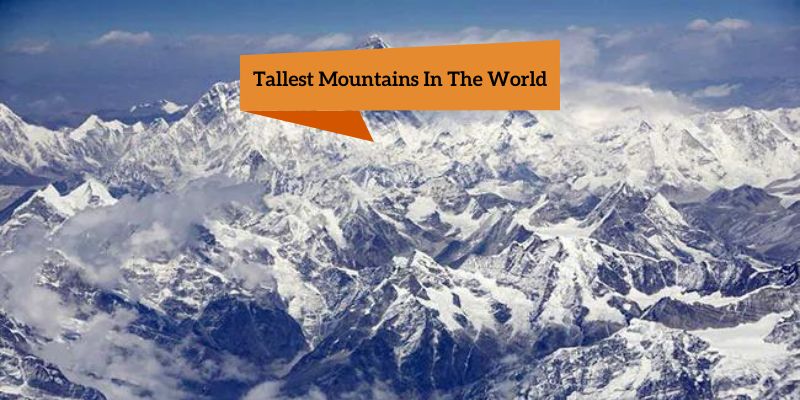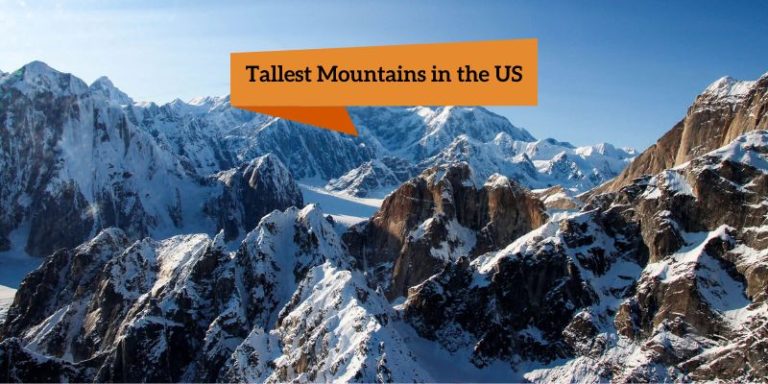Tallest Mountains In The World

Let’s talk about the tallest mountains in the world. Here is the great list of 93 highest mountains worldwide including all the regions like Nepal, China, India, Pakistan and other. In this article we’ll provide a brief table guide on tallest mountains in the world with their rank, names, impressive heights, ranges and locations.
List of Tallest Mountains in the World
| Rank | Name | Height | Range | Location |
| 1 | Mount Everest | 8,849 m | Mahalangur Himalaya | Nepal and China |
| 2 | K2 | 8,611 m | Baltoro Karakoram | Pakistan, and China |
| 3 | Kangchenjunga | 8,586 m | Kangchenjunga Himalaya | Nepal and India |
| 4 | Lhotse | 8,516 m | Mahalangur Himalaya | China and Nepal |
| 5 | Makalu | 8,485 m | Mahalangur Himalaya | China and Nepal |
| 6 | Cho Oyu | 8,188 m | Mahalangur Himalaya | China and Nepal |
| 7 | Dhaulagiri I | 8,167 m | Dhaulagiri Himalaya | Nepal |
| 8 | Manaslu | 8,163 m | Manaslu Himalaya | Nepal |
| 9 | Nanga Parbat | 8,126 m | Nanga Parbat Himalaya | Pakistan |
| 10 | Annapurna I | 8,091 m | Annapurna Himalaya | Nepal |
| 11 | Gasherbrum I | 8,080 m | Baltoro Karakoram | Pakistan and China |
| 12 | Broad Peak | 8,051 m | Baltoro Karakoram | Pakistan and China |
| 13 | Gasherbrum II | 8,035 m | Baltoro Karakoram | Pakistan and China |
| 14 | Shishapangma | 8,027 m | Jugal Himalaya | China |
| 15 | Gyachung Kang | 7,980 m | Mahalangur Himalaya | Nepal and China |
| 16 | Gasherbrum III | 7,970 m | Baltoro Karakoram | Pakistan and China |
| 17 | Annapurna II | 7,940 m | Annapurna Himalaya | Nepal |
| 18 | Gasherbrum IV | 7,924 m | Baltoro Karakoram | Pakistan |
| 19 | Himalchuli | 7,893 m | Manaslu Himalaya | Nepal |
| 20 | Distaghil Sar | 7,884 m | Hispar Karakoram | Pakistan |
| 21 | Ngadi Chuli | 7,871 m | Manaslu Himalaya | Nepal |
| 22 | Nuptse | 7,864 m | Lothse | Nepal |
| 23 | Khunyang Chhish | 7,823 m | Dishtigril Sar | Pakistan |
| 24 | Masherbrum (K1) | 7,821 m | Gasherbrum | Pakistan |
| 25 | Nanda Devi | 7,816 m | Garhwal Himalaya | India |
| 26 | Chomo Lonzo | 7,804 m | Mahalangur Himalaya | China |
| 27 | Batura Sar | 7,795 m | Batura Karakoram | Pakistan |
| 28 | Rakaposhi | 7,788 m | Rakaposhi-Haramosh Karakoram | Pakistan |
| 29 | Namcha Barwa | 7,782 m | Assam Himalaya | China |
| 30 | Kanjut Sar | 7,760 m | Hispar Karakoram | Pakistan |
| 31 | Kamet | 7,756 m | Garhwal Himalaya | India |
| 32 | Dhaulagiri II | 7,751 m | Dhaulagiri Himalaya | Nepal |
| 33 | Saltoro Kangri (K10) | 7,742 m | Saltoro Karakoram | Pakistan and India |
| 34 | Kumbhakarna (Jannu) | 7,711 m | Kangchenjunga Himalaya | Nepal |
| 35 | Tirich Mir | 7,708 m | Hindu Kush, | Pakistan |
| 36 | Molamenqing | 7,703 m | Langtang Himalaya | China |
| 37 | Gurla Mandhata | 7,694 m | Nalakankar Himalaya, | China |
| 38 | Saser Kangri I (K22) | 7,672 m | Saser Karakoram | India |
| 39 | Chogolisa | 7,665 m | Masherbrum Karakoram | Pakistan |
| 40 | Dhaulagiri IV | 7,661 m | Dhaulagiri Himalaya | Nepal |
| 41 | Kongur Tagh | 7,649 m | Kongur Shan (Eastern Pamirs) | China |
| 42 | Dhaulagiri V | 7,618 m | Dhaulagiri Himalaya | Nepal |
| 43 | Shispare | 7,611 m | Batura Karakoram | Pakistan |
| 44 | Trivor | 7,577 m | Hispar Karakoram | Pakistan |
| 45 | Gangkhar Puensum | 7,570 m | Kula Kangri Himalaya | Bhutan and China |
| 46 | Gongga Shan (Minya Konka) | 7,556 m | Daxue Mountains (Hengduan Shan) | China |
| 47 | Annapurna III | 7,555 m | Annapurna Himalaya | Nepal |
| 48 | Skyang Kangri | 7,545 m | Baltoro Karakoram | Pakistan and China |
| 49 | Changtse | 7,543 m | Mahalangur Himalaya | China |
| 50 | Kula Kangri | 7,538 m | Kula Kangri Himalaya | China and Bhutan |
| 51 | Kongur Tiube | 7,530 m | Kongur Shan (Eastern Pamirs) | China |
| 52 | Annapurna IV | 7,525 m | Annapurna | Nepal |
| 53 | Mamostong Kangri | 7,516 m | Rimo Karakoram | India |
| 54 | Saser Kangri II E | 7,513 m | Saser Karakoram | India |
| 55 | Muztagh Ata | 7,509 m | Saser Kangri I | India |
| 56 | Ismoil Somoni Peak | 7,495 m | Muztagh Ata | Tajikistan |
| 57 | Saser Kangri III | 7,495 m | Saser Karakoram | India |
| 58 | Noshaq | 7,492 m | Hindu Kush | Afghanistan, Pakistan |
| 59 | Pumari Chhish | 7,492 m | Hispar Karakoram | Pakistan |
| 60 | Passu Sar | 7,476 m | Batura Karakoram | Pakistan |
| 61 | Yukshin Gardan Sar | 7,469m | Hispar Karakoram | Pakistan |
| 62 | Teram Kangri I | 7,462 m | Siachen Karakoram | China, India |
| 63 | Jongsong Peak | 7,462 m | Kangchenjunga Himalaya | India, China, Nepal |
| 64 | Malubiting | 7,458 m | Rakaposhi-Haramosh Karakoram | Pakistan |
| 65 | Gangapurna | 7,455 m | Annapurna Himalaya | Nepal |
| 66 | Jengish Chokusu (Tömür or Pik Pobedy) | 7,439 m | Tian Shan | Kyrgyzstan, China |
| 67 | Sananda Devi | 7,434 m | Garhwal Himalaya | India |
| 68 | K12 | 7,428 m | Saltoro Karakoram | Pakistan, India |
| 69 | Yangra (Ganesh I) | 7,422 m | Ganesh Himalaya | China, Nepal |
| 70 | Sia Kangri | 7,422 m | Siachen Karakoram | Pakistan, China |
| 71 | Momhil Sar | 7,414 m | Hispar Karakoram | Pakistan |
| 72 | Kabru N | 7,412 m | Kangchenjunga Himalaya | India, Nepal |
| 73 | Skil Brum | 7,410 m | Baltoro Karakoram | Pakistan |
| 74 | Haramosh Peak | 7,409 m | Rakaposhi-Haramosh Karakoram | Pakistan |
| 75 | Istor-o-Nal | 7,403 m | Hindu Kush, | Pakistan |
| 76 | Ghent Kangri | 7,401 m | Saltoro Karakoram, | Pakistan, India |
| 77 | Ultar | 7,388 m | Batura Karakoram, | Pakistan |
| 78 | Rimo I | 7,385 m | Rimo Karakoram | India |
| 79 | Churen Himal | 7,385 m | Dhaulagiri Himalaya | Nepal |
| 80 | Teram Kangri III | 7,382 m | Siachen Karakoram | India, China |
| 81 | Sherpi Kangri | 7,380 m | Saltoro Karakoram | Pakistan |
| 82 | Labuche Kang | 7,367 m | Labuche Himalaya | China |
| 63 | Kirat Chuli | 7,362 m | Kangchenjunga Himalaya | Nepal, India |
| 84 | Abi Gamin | 7,355 m | Garhwal Himalaya | India, china |
| 85 | Gimmigila Chuli, The Twins | 7,350 m | Kangchenjunga Himalaya | India, Nepal |
| 86 | Nangpai Gosum | 7,350 m | Mahalangarh | India, China |
| 87 | Saraghrar | 7,349 m | Hindu Kush | Pakistan |
| 88 | Talung | 7,349 m | Kangchenjunga Himalaya | Nepal, India |
| 89 | Jomolhari (Chomo Lhari) | 7,326 m | Jomolhari Himalaya | Bhutan, China |
| 90 | Chamlang | 7,321 m | Mahalangur Himalaya | Nepal |
| 91 | Chongtar | 7,315 m | Baltoro Karakoram | China |
| 92 | Baltoro Kangri | 7,312 m | Masherbrum Krakrum | Pakistan |
| 93 | Siguang Ri | 7,309 m | Mahalangur Himalaya | China |
So, these are the highest mountain peaks on earth including their names, ranks, heights, ranges and location. If you found any mistake in the article let us know to solve it.
FAQs
What is the tallest mountain in the world?
With a height of 8849 m the Mount Everest peak is the heighest mountain peak in the world.
Is K2 taller the Everest?
No, K2 is marked as the second highest peak in the world with a height of 8611 m.

